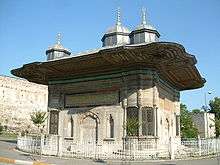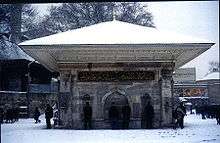Sebil (fountain)
A sebil or sabil (Arabic: سبيل) is a public water fountain, often decorated with stone carvings. Sebils were built at crossroads and outside mosques throughout the Ottoman Empire to provide drinking water for travelers and enable ritual purification before prayer. The construction of many sebils was considered the hallmark of a beneficent ruler. [1]
History
In 16th century Istanbul, sebils were a symbol of public possession. The attempt to add spigots was opposed because this was perceived as limiting public access to the blessings of nature. Endowing money for the construction of sebils was considered an act of piety. Initially, they functioned as kiosks where water was distributed to passersby.[2] Often they were decorated in the Ottoman Rococo style and inscripted with Ottoman Turkish verses that formed a chronogram using the Abjad numbers to date the construction. Until the spread of inhouse plumbing by the end of the 20th century, they were essential for the daily life of the inhabitants of Istanbul.
Gallery
 Sebil outside Rachel's Tomb
Sebil outside Rachel's Tomb
 Sebil in Tel Aviv
Sebil in Tel Aviv

 Sebil of Ali Bey Al-Kabir in Tanta, Egypt
Sebil of Ali Bey Al-Kabir in Tanta, Egypt
.jpg)
See also
- Shadirvan, a typical Ottoman fountain usually built in the yard or at the entrance of religious buildings (mosques, khanqahs, madrasas) and caravanserais
- Wudu, ritual purification in Islam
References
External links
| Wikimedia Commons has media related to Sebils. |
- Sebil in the dictionary of Islamic architecture
- Fountains of Istanbul
_in_Lod.jpg)